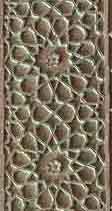REQUIRED
WORK:
*C. M. Naim
and Carla
Petievich, "Urdu in Lucknow / Lucknow in Urdu," in Lucknow:
Memories of a City, ed. by Violette Graff (New Delhi: Oxford
University
Press, 1997), pp. 165-180: on
the CU website.
Frances W.
Pritchett, Nets
of Awareness (Berkeley: Univ. of California Press, 1994)
*"Beyond a
Sea of
Blood," Chapter 2, pp. 16-30
*"Reconstruction,"
Chapter
3, pp. 31-45.
*"The Water
of Life," Chapter
4, pp. 46-59
These chapters
online
at CU: Chapter 2; Chapter
3; Chapter 4.
Also: online
at the Univ. of California Press website.
also, online
through NetLibrary. Once within their system, you can go to the exact
location.
Ralph
Russell, "The Islam
of Urdu Poetry," The Hindu, April 7, 2002: online
through The Hindu; and online
at CU.
Ralph
Russell and Khurshidul
Islam,"The Revolt of 1857," in Ghalib: Life and Letters (Cambridge:
Harvard University Press, 1969), Chapter 6, pp. 132-155. BUTLER
RESERVE.
Also: these
pages
online at CU.
|
SPECIAL:
URDU
POETRY TEXTS WE WILL USE IN CLASS
the
ghazal *yih
nah thi* in Urdu script (jpg image)
the
ghazal *yih
nah thi* in Hindi script (jpg image)
-->
the *worksheet*
analyzing this ghazal (PDF) <-- I will bring it to class
If
you REALLY want
to understand the ghazal, and are feeling brave,
here's
the genuine
article: {20}
(click on the verse numbers for individual verse comments, and notice
that
you can change the script display options)
If we
have time, we
will also listen to a brief modern poem, or "nazm," by Faiz: here it is
in PDF form: *dasht-e
tanha'i
meN*
|
POSSIBLE
PAPER TOPIC EIGHT:
Ghalib was
the first
poet in Urdu literary history to oversee the publication of his divan
of poetry-- four times within his lifetime. He also corresponded
constantly,
using both traditional messengers and the new British-run postal
system.
From his letters in the Russell and Islam book, what can you learn
about
his relationship with these various means of distribution and
communication?
Source: Ralph Russell and Khurshidul Islam, Ghalib: Life
and
Letters (Cambridge: Harvard University Press, 1969).



